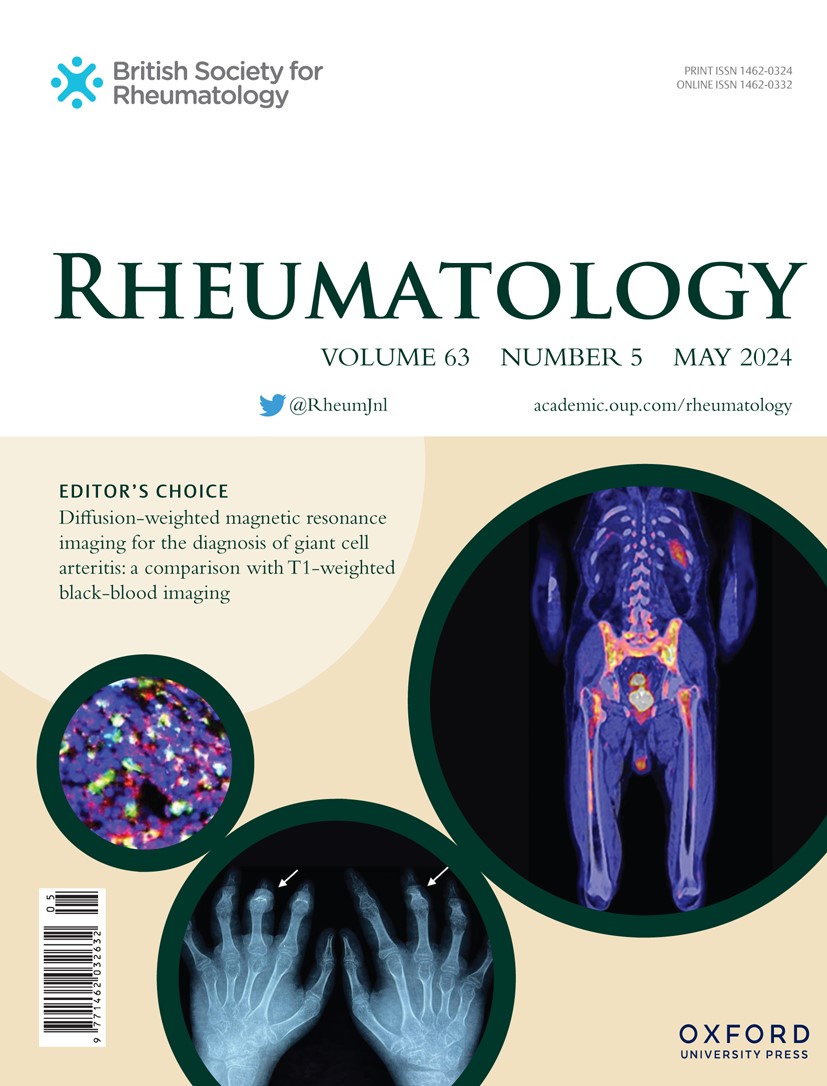Exploring the impact of conventional and targeted disease modifying anti-rheumatic drugs on body weight in patients with psoriatic arthritis
IF 4.7
2区 医学
Q1 RHEUMATOLOGY
引用次数: 0
Abstract
Objectives To evaluate change in body weight with disease-modifying antirheumatic drugs (DMARD) in psoriatic arthritis (PsA). Methods We analyzed data from a large cohort of PsA patients with at least two weight measurements over follow-up. The absolute weight difference at one year from drug initiation was evaluated across—no medications or non-steroidal anti-inflammatory drugs (NSAIDs), conventional synthetic (cs) DMARDs, tumour necrosis factor inhibitors (TNFi), interleukin (IL)-12/23 inhibitor (i), IL-17i, IL-23i, Janus kinase inhibitors (JAKi), and apremilast classes. Two separate linear mixed models examined trends in weight change before and after treatment initiation with change point modeling and factors affecting weight over follow-up. Results Of 1754 patients, 473 were on NSAIDs or no medications, 571 on csDMARDs, 702 on bDMARDs, 42 on JAKi, and 70 on apremilast. Compared with weight at drug initiation, TNFi was associated with a weight gain at one year (1.54 kg, p< 0.01), whereas no significant change was observed with other drug classes. On change-point modeling, a significant decrease in the rate of weight change was observed following IL-17i (slope 0.63 ± 0.20 vs -0.26 ± 0.25, p< 0.01), IL-23i (0.82 ± 0.34 vs -0.56 ± 0.56, p< 0.01), and csDMARDs (0.43 ± 0.24 vs -0.20 ± 0.26, p< 0.01) compared with before treatment initiation. Factors associated with weight gain over follow-up included TNFi, IL12/23i use, male sex, follow-up duration, and higher baseline weight, while with weight loss were apremilast, older age, and diabetes mellitus. Conclusion The rate of weight gain significantly decreases following the initiation of IL-17i, IL-23i, and csDMARDs in PsA. Overall, TNFi and IL12/23i use is associated with weight gain, while apremilast with weight loss.探讨常规和靶向抗风湿药物对银屑病关节炎患者体重的影响
目的评价银屑病关节炎(PsA)患者使用改善疾病的抗风湿药物(DMARD)后体重的变化。方法:我们分析了一大批PsA患者的数据,这些患者在随访期间至少进行了两次体重测量。从用药开始一年的绝对体重差进行评估,包括无药物或非甾体抗炎药(NSAIDs)、常规合成(cs) DMARDs、肿瘤坏死因子抑制剂(TNFi)、白细胞介素(IL)-12/23抑制剂(i)、IL-17i、IL-23i、Janus激酶抑制剂(JAKi)和阿普米司特。两个独立的线性混合模型检查了治疗开始前后体重变化的趋势,采用变化点模型和影响体重的因素。结果在1754例患者中,473例患者使用非甾体抗炎药或未使用药物,571例使用csDMARDs, 702例使用bDMARDs, 42例使用JAKi, 70例使用阿普米司特。与药物开始时的体重相比,TNFi与一年后的体重增加有关(1.54 kg, p<;0.01),而其他药物类别无显著变化。在变化点模型中,IL-17i后体重变化率显著降低(斜率0.63±0.20 vs -0.26±0.25,p<;0.01), IL-23i(0.82±0.34 vs -0.56±0.56);0.01), csDMARDs(0.43±0.24 vs -0.20±0.26,p < 0.01;0.01)。与随访期间体重增加相关的因素包括TNFi、IL12/23i的使用、男性、随访时间和较高的基线体重,而体重减轻的因素包括阿普雷米斯特、年龄较大和糖尿病。结论在PsA中启动IL-17i、IL-23i和csDMARDs后,体重增加率明显降低。总的来说,使用TNFi和IL12/23i与体重增加有关,而阿普米司特与体重减轻有关。
本文章由计算机程序翻译,如有差异,请以英文原文为准。
求助全文
约1分钟内获得全文
求助全文
来源期刊

Rheumatology
医学-风湿病学
CiteScore
9.40
自引率
7.30%
发文量
1091
审稿时长
2 months
期刊介绍:
Rheumatology strives to support research and discovery by publishing the highest quality original scientific papers with a focus on basic, clinical and translational research. The journal’s subject areas cover a wide range of paediatric and adult rheumatological conditions from an international perspective. It is an official journal of the British Society for Rheumatology, published by Oxford University Press.
Rheumatology publishes original articles, reviews, editorials, guidelines, concise reports, meta-analyses, original case reports, clinical vignettes, letters and matters arising from published material. The journal takes pride in serving the global rheumatology community, with a focus on high societal impact in the form of podcasts, videos and extended social media presence, and utilizing metrics such as Altmetric. Keep up to date by following the journal on Twitter @RheumJnl.
 求助内容:
求助内容: 应助结果提醒方式:
应助结果提醒方式:


